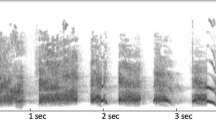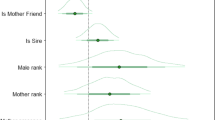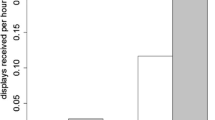Abstract
When agonistic interventions are nepotistic, individuals are expected to side more often with kin but less often against kin in comparison with non-kin. As yet, however, few mammal studies have been in a position to test the validity of this assertion with respect to paternal relatedness. We therefore used molecular genetic kinship testing to assess whether adult female rhesus macaques (Macaca mulatta) from the free-ranging colony of Cayo Santiago (Puerto Rico) bias their interventions in ongoing dyadic aggressive interactions towards maternal and paternal half-sisters compared with unrelated females. It turned out that females supported maternal half-sisters significantly more often than paternal half-sisters or non-kin regardless of the costs associated with such interventions. Similarly, females targeted maternal half-sisters significantly less often than non-kin when this was associated with high costs. Unrelated females provided significantly higher mean rates of both high- and low-cost support to each other than did paternal half-sisters. However, females targeted paternal half-sisters significantly less often than non-kin when targeting was at low cost, suggesting that females refrain from intervening against paternal half-sisters. Our data confirm the general view that coalition formation in female mammals is a function of both the level of maternal relatedness and of the costs of intervention. The patterns of coalition formation among paternal kin were found to be more complex, and may also differ across species, but clear evidence for paternal kin discrimination was observed in female rhesus as predicted by kin selection theory.
Similar content being viewed by others
References
Alexander RD (1974) The evolution of social behavior. Annu Rev Ecol Syst 5:325–383
Altmann J (1974) Observational study of behavior sampling methods. Behaviour 49:227–267
Altmann J, Alberts SC, Haines SA, Dubach J, Muruthi P, Coote T, Geffen E, Cheesman DJ, Mututua RS, Saiyalel SN, Wayne RK, Lacy RC, Bruford MW (1996) Behavior predicts genetic structure in a wild primate group. Proc Nat Acad Sci USA 93:5797–5801
Bercovitch FB (1988) Coalitions, cooperation and reproductive tactics among adult male baboons. Anim Behav 36:1198–1209
Bercovitch FB, Widdig A, Berard JD, Nürnberg P, Kessler MJ, Schmidtke J, Trefilov A, Krawczak M (2002) Multiple sirehood in free-ranging twin rhesus macaques, Macaca mulatta. Am J Primatol 57:31–34
Bercovitch FB, Widdig A, Trefilov A, Kessler MJ, Berard JD, Schmidtke J, Nürnberg P, Krawczak M (2003) A longitudinal study of age-specific reproductive output and body condition among male rhesus macaques, Macaca mulatta. Naturwissenschaften 90:309–312
Bernstein IS (1991) The correlation between kinship and behaviour in non-human primates. In: Hepper PG (ed) Kin recognition. Cambridge University Press, Cambridge, pp 6–29
Bernstein IS, Ehardt CL (1985) Agonistic aiding: kinship, rank, age and sex influences. Am J Primatol 8:37–52
Bernstein IS, Ehardt CL (1986) The influence of kinship and socialization on aggressive behaviour in rhesus monkeys (Macaca mulatta). Anim Behav 34:739–747
Cant MA (2000) Social control of reproduction in banded mongooses. Anim Behav 59:147–158
Chapais B (1992) The role of alliances in social inheritance of rank among female primates. In: Harcourt AH, de Waal FBM (eds) Coalitions and alliances in humans and other animals. Oxford University Press, Oxford, pp 29–59
Chapais B (1995) Alliances as a means of competition in primates: evolutionary, developmental, and cognitive aspects. Yearb Phys Anthropol (Wash) 38:115–136
Chapais B (2001) Primate nepotism: what is the explanatory value of kin selection? Int J Primatol 22:203–229
Chapais B, Girad M, Primi G (1991) Non-kin alliances, and the stability of matrilineal dominance relations in Japanese macaques. Anim Behav 41:481–491
Chapais B, Prud’homme J, Teijeiro S (1994) Dominance competition among siblings in Japanese macaques: constraints on nepotism. Anim Behav 48:1335–1347
Chapais B, Gauthier C, Prud’homme J, Vasey P (1997) Relatedness threshold for nepotism in Japanese macaques. Anim Behav 53:1089–1101
Charpentier M, Peignot P, Hossaert-McKey M, Gimenez O, Setchell JM, Wickings EJ (2005) Constraints on control: factors influencing reproductive success in male mandrills (Mandrillus sphinx). Behav Ecol 16:614–623
Charpentier M, Peignot P, Hossaert-McKey M, Wickings EJ (2006) Kin recognition in juvenile mandrills (Mandrillus sphinx) Anim Behav (in press)
Colvin J (1983) Rank influences rhesus male peer relationship. In: Hinde RA (ed) Primate social relationship, an integrated approach. Blackwell, Oxford, pp 57–64
Cooney R, Bennett NC (2000) Inbreeding avoidance and reproductive skew in a cooperative mammal. Proc R Soc Lond B Biol Sci 267:801–806
Connor RC, Smolker RA, Richards AF (1992) Dolphin alliances and coalitions. In: Harcourt AH, de Waal FBM (eds) Coalitions and alliances in humans and other animals. Oxford University Press, Oxford, pp 415–443
Connor RC, Heithaus RM, Barre LM (1999) Superalliance of bottlenose dolphins. Nature 371:571–572
Datta SB (1983a) Relative power and the maintenance of dominance. In: Hinde RA (ed) Primate social relationship, an integrated approach. Blackwell, Oxford, pp 103–112
Datta SB (1983b) Patterns of agonistic interference. In: Hinde RA (ed) Primate social relationship, an integrated approach. Blackwell, Oxford, pp 289–297
de Ruiter JR, Geffen E (1998) Relatedness of matrilines, dispersing males and social groups in long-tailed macaques (Macaca fascicularis). Proc R Soc Lond B Biol Sci 265:79–87
de Waal FBM (1991) Rank distance as a central feature of rhesus monkey social organization: a sociometric analysis. Anim Behav 41:383–395
de Waal FBM (1992) Coalitions as part of reciprocal relations in the Arnhem chimpanzee colony. In: Harcourt AH, de Waal FBM (eds) Coalitions and alliances in humans and other animals. Oxford University Press, Oxford, pp 233–257
de Waal FBM, Luttrell LM (1986) The similarity principle underlying social bonding among female rhesus monkeys. Folia Primatol (Basel) 46:215–234
Drickamer LC (1974) A ten-year summary of reproductive data for free-ranging Macaca mulatta. Folia Primatol (Basel) 21:61–80
Ehardt CL, Bernstein IS (1992) Conflict intervention behaviour by adult male macaques: structural and functional aspects. In: Harcourt AH, de Waal FBM (eds) Coalitions and alliances in humans and other animals. Oxford University Press, Oxford, pp 83–111
Engh AL, Esch K, Smale L, Holekamp KE (2000) Mechanisms of maternal rank “inheritance” in spotted hyaena (Crocuta crocuta). Anim Behav 60:323–332
Engh AL, Funk SM, van Horn RC, Scribner KT, Bruford MW, Libants S, Szykman M, Smale L, Holekamp KE (2002) Reproductive skew among males in a female-dominated mammalian society. Behav Ecol 13:193–200
Engh AL, Siebert ER, Greenberg DA, Holekamp KE (2005) Patterns of alliance formation and postconflict aggression indicate spotted hyenas recognize third-party relationships. Anim Behav 69:209–217
Epplen JT (1992) The methodology of multilocus DNA fingerprinting using radioactive or non-radioactive oligonucleotide probes specific for simple repeat motifs. In: Chrambach A, Dunn MJ, Radola BJ (eds) Advances in electrophoresis. VCH, Weinheim, pp 59–114
Erhart EM, Coelho AM, Bramblett CA (1997) Kin recognition by paternal half-siblings in captive Papio cynocephalus. Am J Primatol 43:147–157
Fredrickson WT, Sackett GP (1984) Kin preferences in primates (Macaca nemestrina): relatedness or familiarity? J Comp Psychol 98:29–34
Garnier JN, Bruford MW, Goossens B (2001) Mating system and reproductive skew in the black rhinoceros. Mol Ecol 10:2031–2041
Gouzoules S, Gouzoules H (1987) Kinship. In: Smuts BB, Cheney DL, Seyfarth RM, Wrangham RW, Struhsaker TT (eds) Primate societies. The University of Chicago Press, Chicago, pp 299–305
Greenwood PJ (1980) Mating systems, philopatry and dispersal in birds and mammals. Anim Behav 28:1140–1162
Hamilton WD (1964) The genetical evolution of social behaviour I/II. J Theor Biol 7:1–52
Harcourt AH (1992) Coalitions and alliances: are primates more complex than non-primates? In: Harcourt AH, de Waal FBM (eds) Coalitions and alliances in humans and other animals. Oxford University Press, Oxford, pp 445–471
Harcourt AH, de Waal FBM (eds) (1992) Coalitions and alliances in humans and other animals. Oxford University Press, Oxford
Heinsohn R, Dunn P, Legge S, Double M (2000) Coalitions of relatives and reproductive skew in cooperatively breeding white-winged choughs. Proc R Soc Lond B Biol Sci 267:243–249
Holmes WG (1986) Identification of paternal half-siblings by captive Belding’s ground squirrels. Anim Behav 34:321–327
Kaplan JR (1977) Patterns of fight interference in free-ranging rhesus monkeys. Am J Phys Anthropol 47:279–288
Kaplan JR (1978) Fight interference and altruism in rhesus monkeys. Am J Phys Anthropol 49:241–250
Kapsalis E, Berman CM (1996a) Models of affiliative relationships among free-ranging rhesus monkeys (Macaca mulatta). I. criteria for kinship. Behaviour 133:1209–1234
Kapsalis E, Berman CM (1996b) Models of affiliative relationships among free-ranging rhesus monkeys (Macaca mulatta). II. Testing predictions for three hypothesized organizing principles. Behaviour 133:1235–1263
Keane B (1990) The effect of relatedness on reproductive success and mate choice in the white-footed mouse, Peromyscus leucopus. Anim Behav 39:264–273
Keane B, Dittus WPJ, Melnick DJ (1997) Paternity assessment in wild groups of toque macaques Macaca sinica at Polonnaruwa, Sri Lanka using molecular markers. Mol Ecol 6:267–282
Krawczak M (1999) Statistical inference from DNA evidence. In: Epplen JT, Lubjuhn T (eds) A laboratory guide to DNA fingerprinting/profiling. Birkhäuser, Basel, pp 229–244
Krützen M, Barré LM, Connor RC, Mann J, Sherwin WB (2004) ’O father: where art thou?’—Paternity assessment in an open fission–fusion society of wild bottlenose dolphins (Tursiops sp.) in Shark Bay, West Australia. Mol Ecol 13:1975–1990
Kurland JA (1977) Kin selection in Japanese monkeys. In: Contributions to primatology, vol 12. Karger, Basel
Lindburg DG (1969) Rhesus monkeys: mating season mobility of adult males. Science 166:1176–1178
Martin P, Bateson P (1986) Measuring behaviour. Cambridge University Press, Cambridge
Massey A (1977) Agonistic aids and kinship in a group of pigtail macaques. Behav Ecol Sociobiol l2:31–40
Nielsen R, Mattila DK, Clapham PJ, Palsboell PJ (2001) Statistical approaches to paternity analysis in natural populations and applications to the North Atlantic humpback whale. Genetics 157:1673–1682
Noë R (1992) Alliance formation among male baboons: shopping for profitable partners. In: Harcourt AH, de Waal FBM (eds) Coalitions and alliances in humans and other animals. Oxford University Press, Oxford, pp 285–321
Noë R, Sluijter AA (1995) Which adult male savanna baboons form coalitions? Int J Primatol 16:77–105
Nürnberg P, Sauermann U, Kayser M, Lanfer C, Manns E, Widdig A, Berard J, Bercovitch FB, Kessler M, Schmidtke J, Krawczak M (1998) Paternity assessment in rhesus macaques (Macaca mulatta). Multilocus DNA fingerprinting and PCR marker typing. Am J Primatol 44:1–18
Packer C, Gilbert DA, Pusey AE, O’Brien SJ (1991) A molecular genetic analysis of kinship and cooperation in African lions. Nature 351:562–565
Pfennig DW, Reeve HK, Sherman PW (1993) Kin recognition and cannibalism in spadefoot toad tadpoles. Anim Behav 46:87–94
Pusey AE (1987) Sex-biased dispersal and inbreeding avoidance in birds and mammals. Trends Ecol Evol 2:295–299
Rawlins RG, Kessler MJ (eds) (1986) The Cayo Santiago macaques. History, behavior and biology. State University of New York Press, Albany
Sackett GP, Fredrickson WT (1987) Social preferences by pigtailed macaques familiarity versus degree and type of kinship. Anim Behav 35:603–606
Say L, Naulty F, Hayden TJ (2003) Genetic and behavioral estimates of reproductive skew in male fallow deer. Mol Ecol 12:2793–2800
Seth PK, Seth S (1986) Ecology and behavior of rhesus monkeys in India. In: Else JG, Lee PC (eds) Primate Ecology and conservation, vol 2. Cambridge University Press, Cambridge, pp 192–305
Silk JB (1982) Altruism among female Macaca radiata: explanations and analysis of patterns of grooming and coalition formation. Behaviour 79:162–188
Silk JB (2002) Kin selection in primate groups. Int J Primatol 23:849–875
Silk JB, Samuels A, Rodman PS (1981) The influence of kinship, rank, and sex on affiliation and aggression between adult female and immature bonnet macaques (Macaca radiata). Behaviour 78:111–137
Silk JB, Short J, Roberts J, Kusnitz J (1991) Gestation length in rhesus macaques (Macaca mulatta). Int J Primatol 14:95–104
Silk JB, Alberts SC, Altmann J (2004) Patterns of coalition formation by adult female baboons in Amboseli, Kenya. Anim Behav 67:573–582
Silk JB, Alberts SC, Altmann J (2006) Social relationships among adult female baboons (Papio cynocephalus). I. Variation in the strength of social bonds. Behav Ecol Socioiol (in press)
Smith KL, Alberts SC, Altmann J (2003) Wild female baboons bias their social behaviour towards paternal half-sisters. Proc R Soc Lond B Biol Sci 270:503–510
Sokal RR, Rohlf FJ (1995) Biometry, 3rd edn. Freeman, New York
Southwick CH, Yongzu Z, Haisheng J, Zhenhe L, Wenyuan Q (1996) Population ecology of rhesus macaques in tropical and temperate habitats in China. In: Fa JE, Lindburg DG (eds) Evolution and ecology of macaque societies. Cambridge University Press, Cambridge, pp 95–105
Todrank J, Heth G, Johnston RE (1998) Kin recognition in golden hamsters: evidence for kinship odour. Anim Behav 55:377–386
Wahaj SA, van Horn RC, van Horn TL, Dreyer R, Hilgris R, Schwarz J, Holekamp KE (2004) Kin discrimination in the spotted hyena (Crocuta crocuta): nepotism among siblings. Behav Ecol Sociobiol 56:237–247
Waldman B, Frumhoff PC, Sherman PW (1988) Problems of kin recognition. Trends Ecol Evol 3:8–13
Walters J (1980) Interventions and the development of dominance relationships in female baboons. Folia Primatol (Basel) 34:61–89
Walters JR (1987) Kin recognition in non-human primates. In: Fletcher DJC, Michener CD (eds) Kin recognition in animals. Wiley, Chichester, pp 359–393
Waser PM, Keane B, Creel SR, Elliott LF, Minchella DJ (1994) Possible male coalitions in a solitary mongoose. Anim Behav 47:289–294
Welker C, Schwibbe MH, Schäfer-Witt C, Visalberghi E (1987) Failure of kin recognition in Macaca fascicularis. Folia Primatol (Basel) 49:216–221
West SA, Pen I, Griffin AS (2002) Cooperation and competition between relatives. Science 296:72–75
Widdig A (2002) Paternal kinship among adult female rhesus macaques (Macaca mulatta). Ph.D. thesis, Humboldt University Berlin. http://edoc.hu-berlin.de/dissertationen/widdig-anja-2002-07-17/
Widdig A, Streich WJ, Tembrock G (2000) Coalition formation among male Barbary macaques (Macaca sylvanus). Am J Primatol 50:37–51
Widdig A, Nürnberg P, Krawczak M, Streich WJ, Bercovitch FB (2001) Paternal relatedness and age proximity regulate social relationships among adult female rhesus macaques. Proc Nat Acad Sci USA 98:13769–13773
Widdig A, Nürnberg P, Krawczak M, Streich WJ, Bercovitch FB (2002) Affiliation and aggression among adult female rhesus macaques: a genetic analysis of paternal cohorts. Behaviour 139:371–391
Widdig A, Bercovitch FB, Streich WJ, Nürnberg P, Krawczak M (2004) A longitudinal analysis of reproductive skew in male rhesus macaques. Proc R Soc Lond B Biol Sci 271:819–826
Wu HMH, Holmes WG, Medina SR, Sackett GP (1980) Kin preference in infant Macaca nemestrina. Nature 285:225–227
Zabel CJ, Glickman SE, Frank LG, Woodmansee KB, Keppel G (1992) Coalition formation in a colony of prepubertal spotted hyenas. In: Harcourt AH, de Waal FBM (eds) Coalitions and alliances in humans and other animals. Oxford University Press, Oxford, pp 113–135
Acknowledgements
We thank M. Kessler and J. Berard for permission to work on Cayo Santiago, H. Rösler, I. Barth and A. Trefilov for technical assistance, A. Wollstein and L. Kulik for computer assistance and H. Stenzel for computing the number of opportunities. We are grateful for the constructive comments of five anonymous referees which greatly improved the article. Research was funded by the Deutsche Forschungsgemeinschaft (DFG; Nu 50/3-1,2, Nu 50/6-1, Wi 1808), Deutscher Akademischer Austausch Dienst (DAAD; to A.W.), national A NaFöG (to A.W.), Fazit-Stiftung (to A.W.), Sandmann-Stiftung (to A.W.), Virchow-Klinikum, UPR Medical Sciences Campus, National Institutes of Health (NIH) [National Center for Research Resources (NCRR) grant CM-5-P40RR003640 award to the CPRC], National Science Foundation (NSF) (to F.B.B.) and through an Emmy–Noether grant from the DFG awarded to A.W. All research procedures were approved by the CPRC and the Institutional Animal Care and Use Committee of the University of Puerto Rico, Medical Sciences Campus, in accordance with US Department of Agriculture (USDA) regulations and NIH guidelines.
Author information
Authors and Affiliations
Corresponding author
Additional information
Communicated by P. Kappeler
Rights and permissions
About this article
Cite this article
Widdig, A., Streich, W.J., Nürnberg, P. et al. Paternal kin bias in the agonistic interventions of adult female rhesus macaques (Macaca mulatta). Behav Ecol Sociobiol 61, 205–214 (2006). https://doi.org/10.1007/s00265-006-0251-8
Received:
Revised:
Accepted:
Published:
Issue Date:
DOI: https://doi.org/10.1007/s00265-006-0251-8




